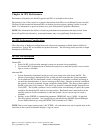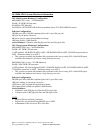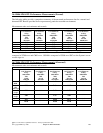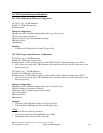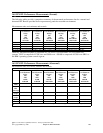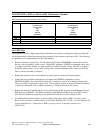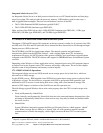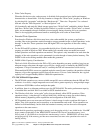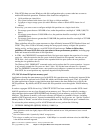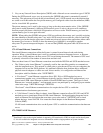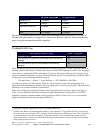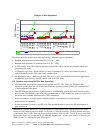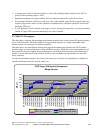
Integrated xSeries Servers (IXS)
An Integrated xSeries Server is an Intel processor-based server on a PCI-based interface card that plugs
into a host system. This card provides the processor, memory, USB interfaces, and in some cases, a
built-in gigabit Ethernet adapter. There are several hardware versions of the IXS:
y The 2.0 GHz Pentium® M IXS (hardware type #4812-001)
6
.
y The 2.0 GHz PCI IXS (hardware type #2892-002).
Older versions of the IXS Card are: the 1.6 GHz PCI IXS (hardware type #2892-001), 1 GHz (type
#2890-003), 850 Mhz (type #2890-002), and 700 MHz (type #2890-001).
17.2 Effects of Windows and Linux loads on the host system
The impact of IXS and IXA device I/O operations on the host system is similar for all versions of the IXA
and IXS cards. The IXA and IXS cards and drivers channel the host directed device I/O through an Input /
Output processor (IOP) on the card..
The iSCSI HBA is an IOP-less input/output adapter. The internal operation and performance
characteristics differ from the IXS/IXA solutions - with a slightly higher host CPU, and memory
requirements. However, the iSCSI solution offers greater scalability and overall improved performance
compared to the IXS/IXA. The iSCSI solution adds support for IBM BladeCenter and additional System
x models.
Depending on the Windows or Linux application activity, integrated guest server I/O operations impose
an indirect load on the System i native CPU, memory and storage subsystems. The rest of this chapter
describes some of the performance and memory resource impacts.
17.2.1 IXS/IXA Disk I/O Operations:
The integrated xSeries servers use i5/OS network server storage spaces for its hard drives, which are
allocated out of i5/OS storage.
For the IXS/IXA server - IBM supplied virtual SCSI drivers render these storage spaces as physical disks
in Windows or Linux. The device drivers cooperate with i5/OS to perform the disk operations, and
additional host CPU resource is used during disk access, along with a fixed amount of storage. The
amount of CPU impact is a function of the disk I/O rate and disk operation size.
The disk linkage type and Windows driver write cache property alters the CPU cost and average write
latency.
y Fixed and Dynamically Linked Disks
Fixed (statically) and dynamically linked disk drives have the same performance characteristics. One
advantage of dynamically linked drives is that in most cases, they may be linked and unlinked while
the server is active.
y Shared Disks
System i Windows integration supports the Microsoft Clustering Service, which supports “shared”
disks. When a storage space is linked as a “shared” disk, all write operations require extended
communications to insure data integrity, which slightly increases the host CPU cost and response
time.
IBM i 6.1 Performance Capabilities Reference - January/April/October 2008
© Copyright IBM Corp. 2008 Chapter 17 - Integrated BladeCenter and System x Performance 281
6
Requires a separate IOP card, which is included with features 4811, 4812 and 4813.



